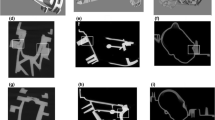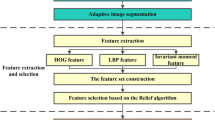Abstract
This manuscript is concerned with the development of digital inspection of casting defects using x-ray radiography images. An efficient approach for detection and classification time of casting defects in x-ray radiography images is proposed. The accuracy of this approach depends on suggested algorithms for background correction, image de-noising, image enhancement and image segmentation of casting defects. Three different algorithms are introduced for automatic detection of casting defects in x-ray images. These algorithms depend on features extraction power density spectrum (PDS) and high order statistics (HOS). An artificial neural network is utilized as a classifier for matching purposes of extracted features. The results show that HOS achieved the best recognition rate of 100% for casting defects in X-ray radiography images in comparison with other algorithms. Besides, a reduction of classification time for casting defects is another target in this paper. It is achieved using costly powerful digital processing hardware and advanced software. Furthermore, an algorithm is realized to reduce classification time of casting defects. This algorithm depends on textural features that extracted from x-ray images of casting defects. Hence, a feature reduction program code is implemented for reduction of extracted features. This program code is relied on average value of each extracted feature for normal and defect image. The numbers of extracted features are reduced from 22 to 2 features. Therefore, better execution time can be achieved for classification purposes of casting defects. The proposed algorithms are evaluated using Intel core TM i5-3470 CPU with 3.20 GHz and Intel core TM i7-3612QM CPU with 4.00 GHz. Consequently, these algorithms can be transferred into more powerful digital processing hardware such as FPGA and GPU for faster classification of casting defects. The obtained results confirm that proposed algorithms can be applied for a broad range of non-destructive applications using image processing techniques.
Similar content being viewed by others
References
Chapman, H.N. and Nugent, K.A., Coherent lensless X-ray imaging, Nat. Sci., 2010, vol. 4, pp. 833–839.
Bansal, G.J., Digital radiography. A comparison with modern conventional imaging, Postgrad. Med. J., 2006, vol. 82, no. 969, pp. 425–428.
Garibotto, G. et al., White paper on industrial applications of computer vision and pattern recognition, in ICIAP-2013, Part II, LNCS 8157, Petrosino, A., Ed., 2013, pp. 721–730.
Kassie, A.A. and Assfaw, S.B., Minimization of casting defects, IOSR J. Eng., 2013, vol. 3, no. 5, pp. 31–38.
Jadhav, B.R. and Jadhav, S.J., Investigation and analysis of cold shut casting defect and defect reduction by using 7 quality, Int. J. Adv. Eng. Res. Studies, 2013, vol. II, no. IV.
Mery, D., Filbert, D., and Jaeger, T., Image processing for fault detection in aluminum castings, in Analytical Characterization of Aluminum, Steel, and Superalloys, MacKenzie, D.S. and Totten, G.E., Eds., CRC Press, 2005, pp. 701–737.
ElTokhy, M.S. and Mahmoud, Classification of welding flaws in gamma radiography images based on multi-scale wavelet packet feature extraction using support vector machine, J. Nondestr. Eval., 2015, vol. 34, no. 34.
Palakkal, S. and Prabhu, K.M.M., Poisson image de-noising using fast discrete curvelet transform and wave atom, J. Signal Process., 2012, vol. 92, no. 9, pp. 2002–2017.
Demanet, L. and Ying, L., Wave atoms and time upscaling of wave equations, Numerische Mathematik, 2009, vol. 113, no. 1, pp. 1–71.
Demanet, L. and Ying, L., Wave atoms and sparsity of oscillatory patterns, Appl. Comput. Harmonic Anal., 2007, vol. 23, no. 3, pp. 368–387.
Maragos, P., Morphological filtering for image enhancement and feature detection, in Image and Video Processing Handbook, Elsevier-Academic Press, 2004, 2nd Ed., pp. 135–156.
Quan Wang, HMRF-EM-image: Implementation of the hidden markov random field model and its expectation-maximization algorithm, Technical Report, arXiv:1207.3510v1[cs.CV], 2012.
Goliaei, S., Ghorshi, S., and Mortazavi, M., Reconstruction of tomographic medical images using Kalman filter approach, in Proc. Int. Conf. Image Process. Comput. Vision Pattern Recognit., United States, 2011, pp. 236–240.
Mendel, J.M., Tutorial on higher-order statistics (spectra) in signal processing and system theory: theoretical results and some applications, IEEE Proc., 1991, vol. 79, no. 3, pp. 278–305.
Vimina, E.R. and Jacob, K.P., Image retrieval using low level features of object regions with application to occluded images, CIARP, LNCS, 2012, pp. 422–429.
Haralick, R.M., k. Shanmugam, and Dinstein, I., Textural features for image classification, IEEE Trans. Syst. Man Cybern., 1973, vol. SMC-3, no. 6.
Author information
Authors and Affiliations
Corresponding author
Rights and permissions
About this article
Cite this article
El_Tokhy, M.S., Mahmoud, I.I. Development of Digital Inspection Algorithms for X-Ray Radiography Casting Images. Russ J Nondestruct Test 55, 334–343 (2019). https://doi.org/10.1134/S1061830919040053
Received:
Revised:
Accepted:
Published:
Issue Date:
DOI: https://doi.org/10.1134/S1061830919040053




